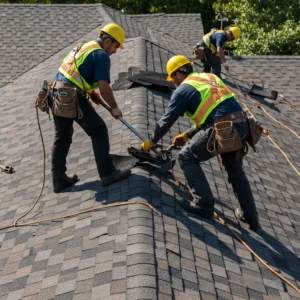How Long Do Roofers Guarantee Their Work in the USA?
A Complete Guide to Roofing Warranties, Coverage, and What to Watch Out For

Understanding Roofing Guarantees: What They Really Mean
In the U.S., roofing guarantees help protect your home and wallet. A roofing guarantee is a promise that the roof will last for a certain number of years. Most roofing contractors offer workmanship warranties, while the manufacturers provide material warranties. These protect against installation errors, material defects, and roof failure within the warranty duration. Whether you're getting a new roof installation, flat roof system, or roof repair, understanding your warranty is key. This protection helps maintain roof structure, roof durability, and overall home protection.
Types of Roof Warranties Explained
There are three main warranty types in the U.S. roofing industry. A workmanship warranty covers errors made during the roof installation—like poor sealing or bad alignment. A manufacturer’s warranty protects against defective roofing materials such as faulty shingles or panels. Then there’s an extended warranty, which gives you added protection for both labor and materials, sometimes for up to 50 years. These warranties often cover extra components like underlayment, venting, and leak barriers. Choosing the right type keeps your roofing system strong and long-lasting.
What’s Covered—and What’s Not—Under Roof Warranties
Roof warranties usually cover labor coverage, material defects, and sometimes component failure. But they don’t cover everything. Most warranties exclude severe weather damage like hail, snowfall, and lightning strikes unless specified in an extended warranty. Also, unauthorized roof alterations, improper roof maintenance, or pressure washing can void your warranty. To stay protected, do regular debris removal, gutter cleaning, and follow all roof maintenance guidelines. Read the full coverage terms to avoid losing your warranty unexpectedly.
Contents
- Understanding Roofing Guarantees: What They Really Mean
- Types of Roof Warranties Explained
- What’s Covered—and What’s Not—Under Roof Warranties
- How Warranty Coverage Changes by Roofing Material
- The Fine Print: Terms, Transferability, and Proration
- Evaluating Roofing Contractors and Warranty Offers
- Filing a Roof Warranty Claim: Steps for a Smooth Process
- Are Roof Warranties Worth It in the Long Run?
How Warranty Coverage Changes by Roofing Material
Your warranty depends on the type of roofing materials you choose. For example, asphalt shingles usually have 20–30-year warranties. 3-tab shingles offer less protection than architectural shingles because they wear out faster. Metal roofs often come with 40–50-year warranties due to their durability and weather resistance. If your roof includes fascia boards, soffit panels, or other special features, the warranty may only cover them if installed by certified contractors. The better the material, the longer and stronger your warranty coverage will be.
The Fine Print: Terms, Transferability, and Proration
It’s important to read the fine print in any roof warranty. One big factor is transferability—this lets you pass the warranty to a new homeowner when selling your house. Another key term is proration, which means the warranty pays less as the roof gets older. You’ll also need to follow valid claim requirements, such as submitting maintenance records or using licensed roofers. Knowing your warranty conditions upfront can save you time, money, and stress if something goes wrong. Never sign off without reading the details.
Evaluating Roofing Contractors and Warranty Offers
Not all roofing companies offer the same quality of work or warranties. A good roofing contractor should provide a solid workmanship warranty, explain what’s covered, and walk you through the claim process. Look for experienced roofers who follow roofing industry standards and use quality roofing materials. Ask about how long their labor is guaranteed and whether they partner with brands that offer long-term warranties. Choosing a reputable roofing company helps ensure your roofing investment is protected for decades.
Filing a Roof Warranty Claim: Steps for a Smooth Process
To file a claim, first review your roof warranty coverage. Then, document your roof condition, collect roof repair records, and contact your warranty provider. Submit your claim within the correct timeline for claims. Avoid DIY roof repairs during this time, as that could void the warranty. Following these steps helps protect your home from more serious issues. Keep up with roof inspections, stick to the warranty protocol, and make sure you meet all claim requirements for fast approval and resolution.
Are Roof Warranties Worth It in the Long Run?
Yes, especially when done right. A strong roof warranty adds value to your home improvement investment and gives you peace of mind. It protects your roofing system components and helps reduce the cost of repairs or replacements. Warranties are especially helpful in areas with extreme weather and protect your home’s energy efficiency and roof integrity. Just make sure you understand the roof coverage terms and work with contractors who use premium roofing solutions. A reliable warranty today can save you thousands tomorrow.

How Long Do Roofers Guarantee Their Work in the USA?
Premium Roofing Solutions Blog How Long Do Roofers Guarantee Their Work in the USA? A Complete Guide to Roofing Warranties, Coverage, and What to Watch
